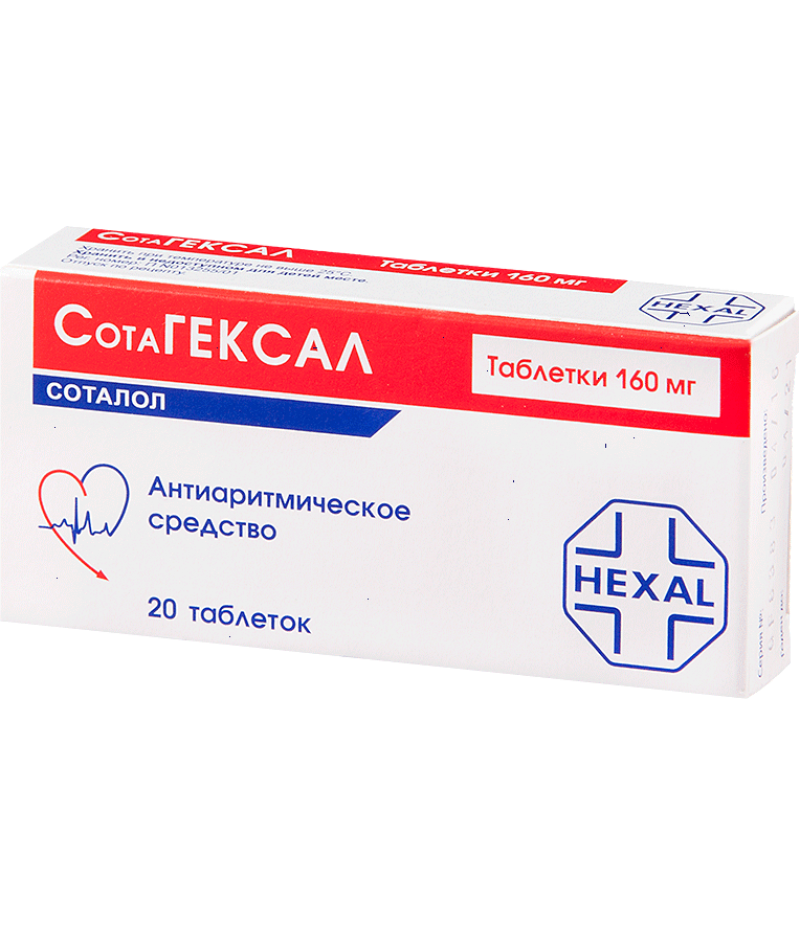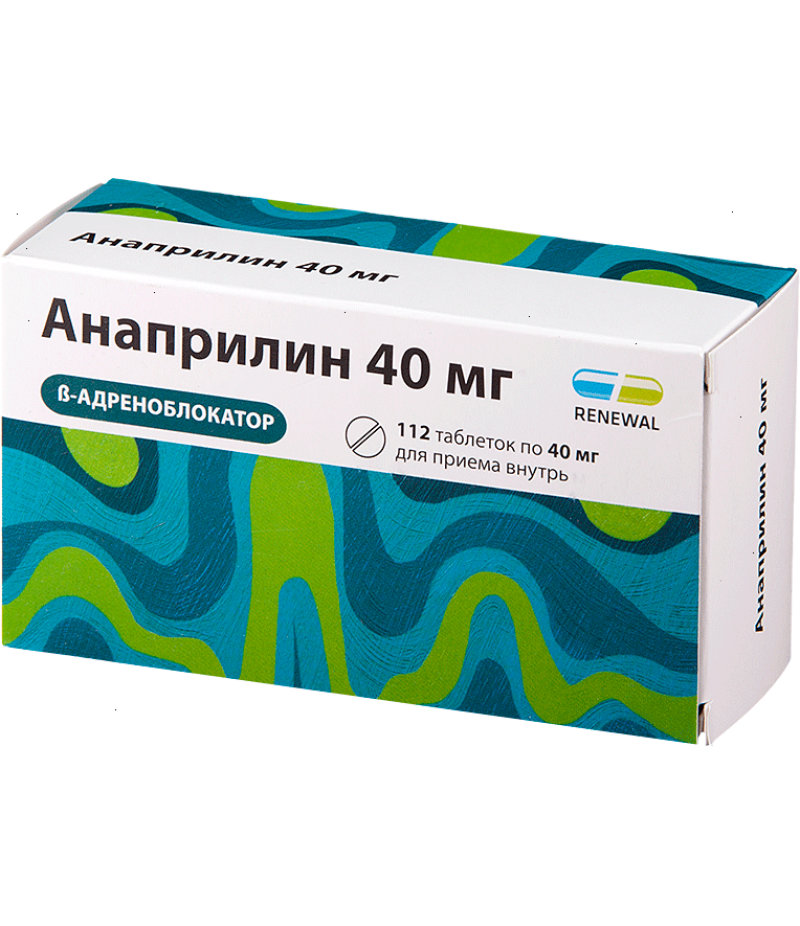Sotahexal tabs 160mg #20
- $8.79
- 3 or more $8.60
- Availability:In Stock
User manual for SotahexalReed more and buy Sotahexal tabsCompositionOne tablet contains 80 mg or 160 mg of sotalol hydrochloride as the active substance.Additional Ingredients: corn starch; magn..
Tags: tabs
User manual for Sotahexal
Reed more and buy Sotahexal tabs
Composition
One tablet contains 80 mg or 160 mg of sotalol hydrochloride as the active substance.
Additional Ingredients:
corn starch;
magnesium stearate;
giprolose;
lactose monohydrate;
silicon dioxide colloidal;
sodium carboxymethyl starch.
Form of issue
Tablets are round, white, convex, on the one hand with an embossed inscription "SOT" and with a risk on the other side. One package - 20, 50 or 100 tablets.
pharmachologic effect
Antiarrhythmic action.
Pharmacodynamics and pharmacokinetics
Sotahexal with the active substance sotalol is a beta1-adrenoblocker, as well as beta 2-adrenoblocker, which does not show its own membrane-stabilizing and sympathomimetic activity. Like other drugs from the group of beta adrenoblockers, sotalol depresses the secretion of renin, both under load and at rest.
Beta-adrenoblokiruyuschee action of Sotahexal is manifested by a decrease in heart rate and a limited decrease in CCC, which reduces the need for oxygen in the myocardium, as well as the load on the heart muscle.
Antiarrhythmic effects are associated with blocking of β-adrenergic receptors, and with extrapolation of the potential of myocardial work. The main effect of the drug is an increase in the duration of effective refractory periods in the pathways of the impulse.
With oral intake bioavailability reaches more than 90%.
In plasma Cmax is observed for 2.5-4 hours.
Absorption of the active substance when eating is reduced by about 20%.
When taking a daily dose in the range from 40 mg to 640 mg, the content of cotalol in the plasma remains proportionally to the dose taken.
Css is observed after 2-3 days.
It does not bind to blood plasma proteins and has a poor penetrating ability through the BBB. In cerebrospinal fluid the concentration of the drug is only 10% of its content in the plasma.
Not exposed to metabolism.
In unchanged form, from 80% to 90% of the dose taken is excreted in the urine, the remainder with feces.
T1 / 2 for 10 to 20 hours.
Indications for use
Indications for the use of Sotahexal are chronic pathologies of the heart rhythm, as well as disorders that are symptomatic:
ventricular tachycardia;
paroxysmal atrial fibrillation;
supraventricular tachycardia, including with WPW syndrome;
ventricular extrasystole.
Contraindications
individual sensitivity to the components of Sotahexal;
AV-blockade (2 and 3 degree);
heart failure;
sinoatrial blockade;
bronchial asthma;
cardiogenic shock;
tachycardia of the "pirouette" type;
sinus bradycardia (at a heart rate less than 55 beats per minute);
syndrome of weakness of the sinus node;
cardiomegaly (without symptoms of heart failure);
severe bradycardia;
angina of Prinzmetal;
chronic obstructive pulmonary disease;
arterial hypotension (with systolic blood pressure less than 90 mm Hg, in particular with myocardial infarction);
syndrome of prolonged QT interval;
Occlusal pathologies of peripheral vessels (aggravated by intermittent claudication, gangrene or pain at rest);
acute myocardial infarction;
metabolic acidosis;
severe allergic rhinitis;
diabetes mellitus complicated by ketoacidosis;
simultaneous therapy with MAO inhibitors;
the period of breastfeeding;
age to 18 years.
The drug Sotahexal with extreme caution is prescribed for allergic reactions in the history, as well as during desensitizing therapy, because of the ability of the drug to suppress sensitivity to allergens.
Side effects
Side effects of the drug Sotahexal are divided according to the principle of its effect on the organs and systems of the human body.
The cardiovascular system:
dyspnea;
bradycardia;
pain behind the sternum;
AV blockade;
cardiopalmus;
edema;
increased symptoms of heart failure;
fainting;
lowering blood pressure;
arrhythmogenic action;
sometimes - increased attacks of angina pectoris.
Digestive system:
dry mouth;
nausea;
diarrhea;
vomiting;
flatulence or constipation;
stomach ache.
Central nervous system:
headache;
increased fatigue;
dizziness;
state of depression;
mood changes;
sense of anxiety;
tremor;
sleep disorders;
asthenia;
paresthesia in the limbs;
depression.
Sense organs:
inflammation of the conjunctiva and cornea of the eye;
visual impairment;
reduction of tear;
hearing impairment;
a violation of taste sensations.
Side effects from the eyes should be taken into account when using the patient's contact lenses.
Endocrine system:
sometimes there was hypoglycemia (mainly in patients with diabetes or adhering to a strict diet).
Respiratory system:
possible bronchospasm (especially when there is a violation of ventilation).
Genitourinary system:
rarely - decreased potency.
Skin:
redness;
itching;
rash;
psoriasis dermatosis;
hives;
alopecia.
Others:
muscle weakness;
fever;
coldness of limbs;
convulsions.
Laboratory indicators:
overestimated results when performing photometric urine analysis for metanephrine.
Instructions for use Sotahexal (Method and dosage)
Please reed the instruction before you buy Sotahexal.
The medicine is taken orally, swallowing the tablet whole and washing it with water. The desired intake of the drug 1-2 hours before meals, as eating reduces the absorption of the drug Sotahexal.
Instructions for use recommend individual selection of the dose of the drug for each patient, depending on its response and the severity of the disease.
As a rule, the initial daily dose of Sotahexal is 80 mg. With an unsatisfactory therapeutic effect, a gradual increase in the initial dose to 240-320 mg per day, divided into 2-3 doses, is possible. The therapeutic effect in most patients is achieved by taking a daily dose of 160 mg to 320 mg divided into 2 doses.
In severe arrhythmias that threaten the life of the patient, you can increase the dose to a maximum of 480 mg divided into 2 or 3 doses. The maximum doses may be prescribed only in extreme cases, when the potential benefit of the drug outweighs the risk of possible side effects (especially proarhythmogenic effect).
Overdose
In case of an accidental overdose, it is possible to lower blood pressure, bronchospasm, bradycardia, hypoglycemia, generalized convulsive attacks, ventricular tachycardia, loss of consciousness.
In rare severe cases, asystole and symptoms of cardiogenic shock were observed.
It shows gastric lavage, the appointment of adsorbents, hemodialysis, as well as symptomatic therapy, including the administration of Atropine (1-2 times intravenously struino); Glucagon (as an infusion with a dose of 0.2 mg / kg of weight, followed by an increase in the dose to 0.5 mg / kg).
Interaction
Simultaneous use of drugs from the group of slow calcium channel blockers, for example, Verapamil and Diltiazem, can lead to a lowering of blood pressure, due to a decrease in contractility. It is necessary to avoid intravenous administration of drugs of this group against the background of Sotalol therapy (except cases of emergency medical care).
With the combined administration of nifedipine and other 1,4-dihydropyridine derivatives, a decrease in blood pressure was observed.
The appointment of MAO inhibitors or Noradrenaline, as well as a sharp withdrawal of clonidine treatment can be the cause of hypertension. Recommend a gradual cessation of Clonidine after a few days after the cancellation of Sotahexal. Beta-adrenoblockers potentiate arterial hypertension withdrawal upon discontinuation of Clonidine therapy, therefore they should be abolished slowly.
A sharp decrease in blood pressure can cause tricyclic antidepressants, phenothiazines, barbiturates, antihypertensives and opioids, vasodilators and diuretics.
The combined use of Class I A antiarrhythmic drugs (especially quinidine type: Procainamide, Quinidine, Dizopyramide) or Class III (Amiodarone) can lead to a pronounced prolongation of the QT interval. Medicines that increase the duration of the QT interval are used with caution with drugs that extend this interval. Among such drugs, in addition to antiarrhythmic drugs of the first class: tricyclic antidepressants, phenothiazines, Astemizol, Terfenadine and some antibiotics of the quinolone series.
The appointment of inhalation anesthesia, including Tubokurarin during therapy with Sotahexal increases the risk of suppression of myocardial function, as well as the development of arterial hypotension.
Simultaneous treatment with Sotahexal and Clonidine, Reserpine, Guangfacin, Alfa-Methyldopa and cardiac glycosides can cause a pronounced bradycardia, as well as a slowing down of the pulse in the heart.
The use of insulin or other oral hypoglycemic medicines, especially under physical exertion, increases hypoglycemia and the severity of its symptoms (tremor, rapid pulse, increased sweating). With diabetes, dosages of hypoglycemic drugs should be adjusted.
Potassium-withdrawing diuretics (hydrochlorothiazide, Furosemide) can cause arrhythmia.
When carrying out therapy with Sotahexal, it may be necessary to use large doses of beta-adrenomimetics (Terbutalin, Salbutamol, Isoprenaline).
Storage conditions
At a temperature of no higher than 25 ° C.
Shelf life - 5 years.
special instructions
Special care should be taken when taking Sotahexal in patients with diabetes mellitus, with fluctuations in blood glucose and with strict diets. Also with psoriasis, including family history, with violations of kidney function (correction of dosing regimen), in old age and with pheochromocytoma (simultaneous use of alpha-blockers is required).
Therapy is carried out under the control of ECG, AD, heart rate. With a marked decrease in blood pressure or a decrease in heart rate, the daily dose of Sotahexal should be adjusted.
The abolition of treatment with Sotahexal should be done slowly under the supervision of the attending physician.
Sotalol should not be prescribed for hypomagnesemia or hypokalemia before stabilizing the existing conditions, which may increase the QT interval and increase the risk of arrhythmia such as pirouette.
It is necessary to control the electrolyte balance and acid-base state in patients with prolonged or severe diarrhea, as well as in patients who receive therapy associated with a decrease in the concentration in the body of magnesium and / or potassium.
Sotalol in thyrotoxicosis can mask some of its clinical manifestations (for example, tachycardia). In this regard, a sharp abolition of therapy in patients with thyrotoxicosis, is contraindicated, because of the possible increase in the symptoms of the disease.
Children
Not appointed at the age of 18 years.
With alcohol
It should be excluded the joint use of the drug Sotahexal and alcohol, since alcohol increases the depression of the central nervous system.
In pregnancy and lactation
The administration of Sotahexal during pregnancy, especially in the first trimester, is possible only for life reasons.
In the case of treatment during pregnancy, the drug should be stopped 48-72 hours before the alleged onset of labor, due to the possible development of hypokalemia, arterial hypotension, bradycardia and respiratory depression in the newborn.
If you need to use the drug Sotahexal during lactation should stop breastfeeding.
Reviews about Sotahexal
With proper selection of doses, compliance with the regimen and all the recommendations of the attending physician, the absence of absolute and relative contraindications, reviews about Sotahexal are mostly positive. Sometimes they describe various side effects, if found, you should consult your doctor to adjust the dose of the drug or replace the therapy.


